steering TOYOTA RAV4 2009 XA30 / 3.G Owners Manual
[x] Cancel search | Manufacturer: TOYOTA, Model Year: 2009, Model line: RAV4, Model: TOYOTA RAV4 2009 XA30 / 3.GPages: 516, PDF Size: 10.61 MB
Page 1 of 516
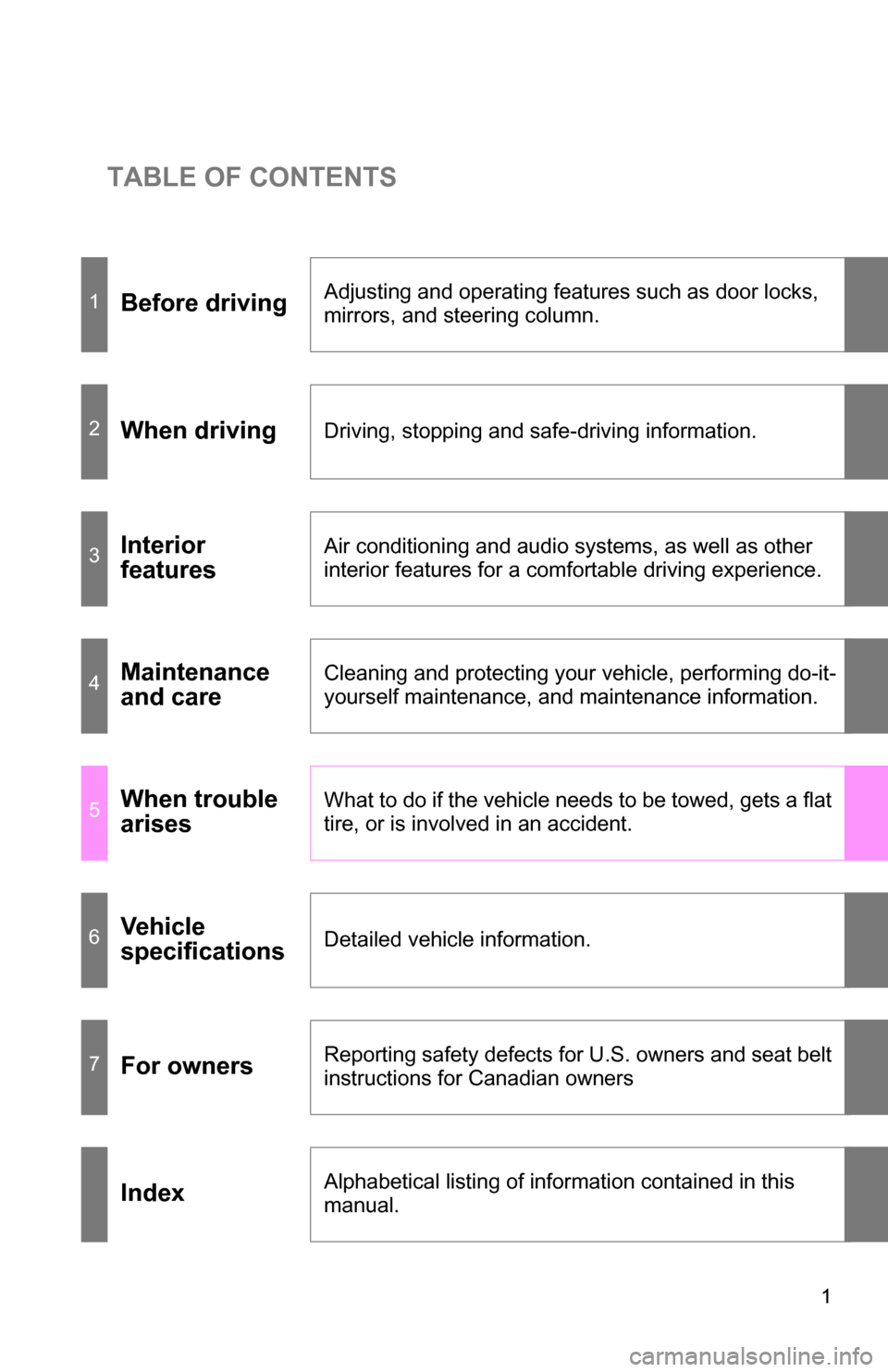
TABLE OF CONTENTS
1
1Before drivingAdjusting and operating features such as door locks,
mirrors, and steering column.
2When drivingDriving, stopping and safe-driving information.
3Interior
featuresAir conditioning and audio systems, as well as other
interior features for a comfortable driving experience.
4Maintenance
and careCleaning and protecting your vehicle, performing do-it-
yourself maintenance, and maintenance information.
5When trouble
arisesWhat to do if the vehicle needs to be towed, gets a flat
tire, or is involved in an accident.
6Vehicle
specificationsDetailed vehicle information.
7For ownersReporting safety defects for U.S. owners and seat belt
instructions for Canadian owners
IndexAlphabetical listing of information contained in this
manual.
Page 2 of 516
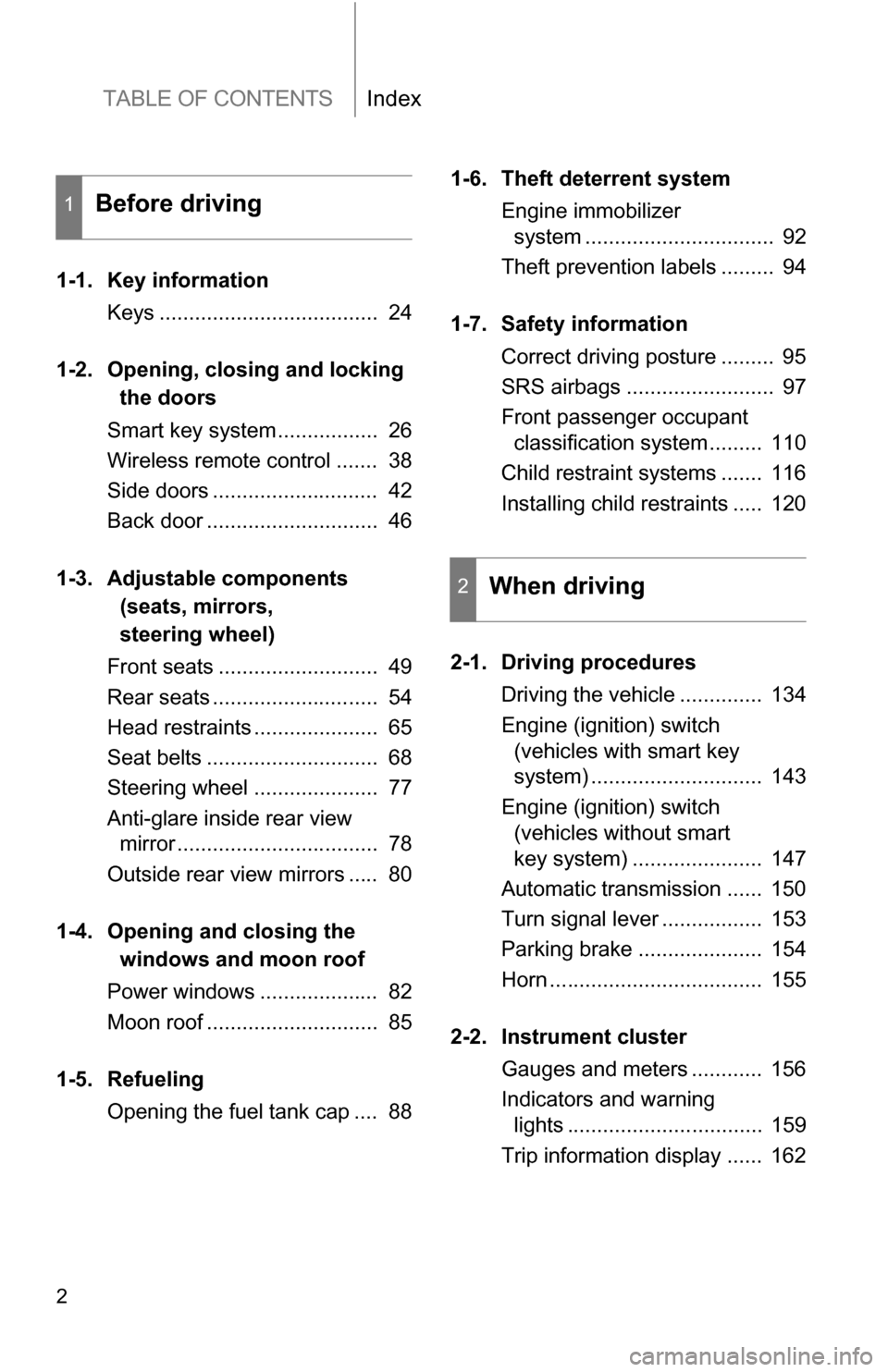
TABLE OF CONTENTSIndex
2
1-1. Key informationKeys ..................................... 24
1-2. Opening, closing and locking
the doors
Smart key system................. 26
Wireless remote control ....... 38
Side doors ............................ 42
Back door ............................. 46
1-3. Adjustable components
(seats, mirrors,
steering wheel)
Front seats ........................... 49
Rear seats ............................ 54
Head restraints ..................... 65
Seat belts ............................. 68
Steering wheel ..................... 77
Anti-glare inside rear view mirror .................................. 78
Outside rear view mirrors ..... 80
1-4. Opening a nd closing the
windo ws and moon roof
Power windows .................... 82
Moon roof ............................. 85
1-5. Refueling Opening the fuel tank cap .... 88 1-6. Theft deterrent system
Engine immobilizer system ................................ 92
Theft prevention labels ......... 94
1-7. Safety information Correct driving posture ......... 95
SRS airbags ......................... 97
Front passenger occupant classification system ......... 110
Child restraint systems ....... 116
Installing child restraints ..... 120
2-1. Driving procedures Driving the vehicle .............. 134
Engine (ignition) switch (vehicles with smart key
system) ............................. 143
Engine (ignition) switch (vehicles without smart
key system) ...................... 147
Automatic transmission ...... 150
Turn signal lever ................. 153
Parking brake ..................... 154
Horn .................................... 155
2-2. Instrument cluster Gauges and meters ............ 156
Indicators and warning lights ................................. 159
Trip information display ...... 162
1Before driving
2When driving
Page 3 of 516
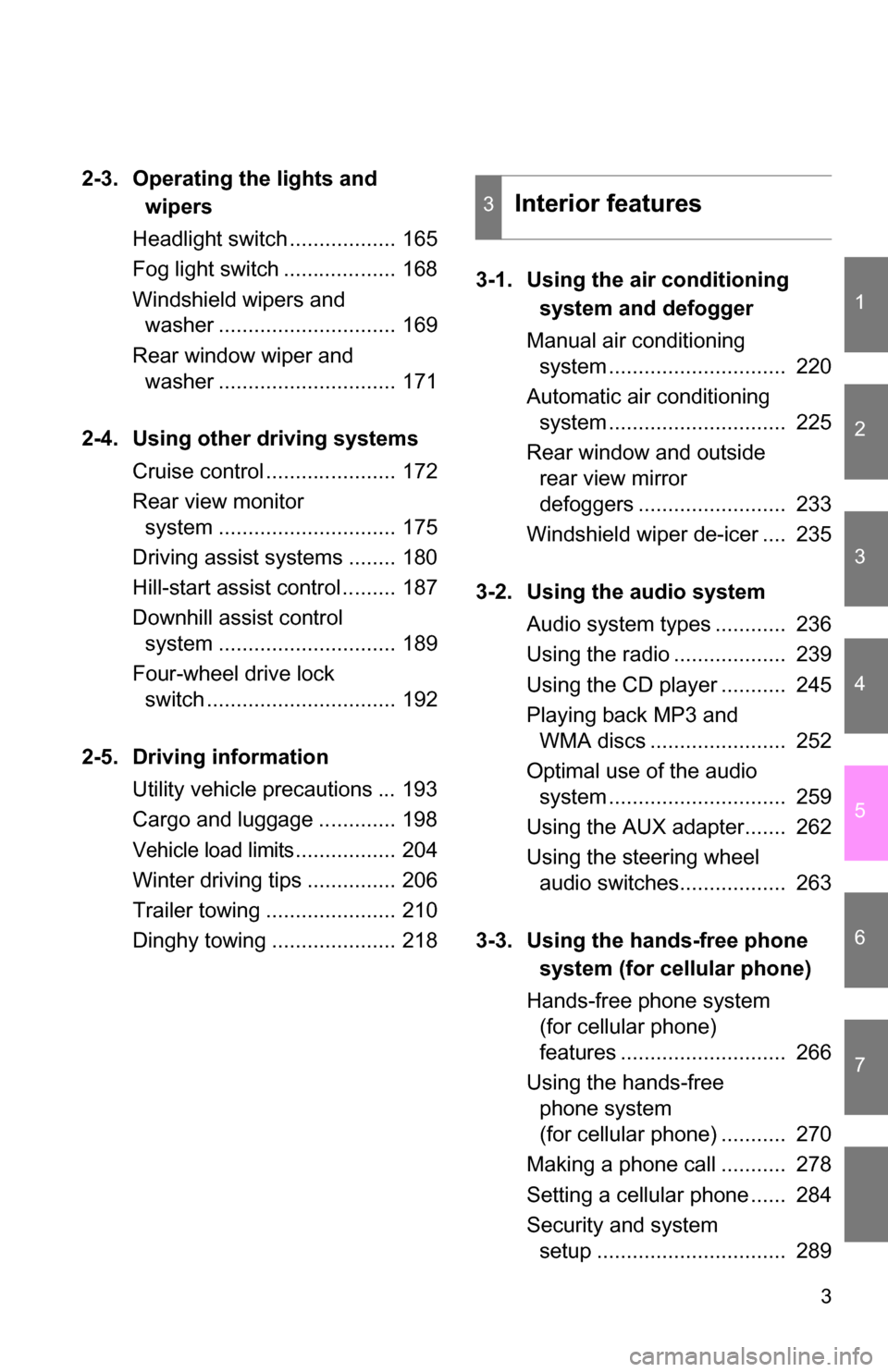
1
2
3
4
5
6
7
3
2-3. Operating the lights and wipers
Headlight switch .................. 165
Fog light switch ................... 168
Windshield wipers and washer .............................. 169
Rear window wiper and washer .............................. 171
2-4. Using other driving systems Cruise control ...................... 172
Rear view monitor system .............................. 175
Driving assist systems ........ 180
Hill-start assist control ......... 187
Downhill assist control system .............................. 189
Four-wheel drive lock switch ................................ 192
2-5. Driving information Utility vehicle precautions ... 193
Cargo and luggage ............. 198
Vehicle load limits................. 204
Winter driving tips ............... 206
Trailer towing ...................... 210
Dinghy towing ..................... 218 3-1. Using the air conditioning
system and defogger
Manual air conditioning system .............................. 220
Automatic air conditioning system .............................. 225
Rear window and outside rear view mirror
defoggers ......................... 233
Windshield wiper de-icer .... 235
3-2. Using the audio system Audio system types ............ 236
Using the radio ................... 239
Using the CD player ........... 245
Playing back MP3 and WMA discs ....................... 252
Optimal use of the audio system .............................. 259
Using the AUX adapter....... 262
Using the steering wheel audio switches.................. 263
3-3. Using the hands-free phone system (for cellular phone)
Hands-free phone system (for cellular phone)
features ............................ 266
Using the hands-free phone system
(for cellular phone) ........... 270
Making a phone call ........... 278
Setting a cellular phone ...... 284
Security and system setup ................................ 289
3Interior features
Page 12 of 516

12
Tilt and telescopic steering lock release lever P. 77
Headlight switch
Turn signal lever
Fog light switch
P. 165
P. 153
P. 168
Windshield wiper and washer switch
Rear window wiper and washer switch P. 169
P. 171
Fuel filler door opener
P. 88
Emergency flasher
switch
P. 410
Four-wheel drive lock switch P. 192
Pictorial indexInstrument panel
Gauges and meters P. 156
Audio system
Navigation system *P. 236
Hood release lever P. 348
Horn P. 155
Page 23 of 516
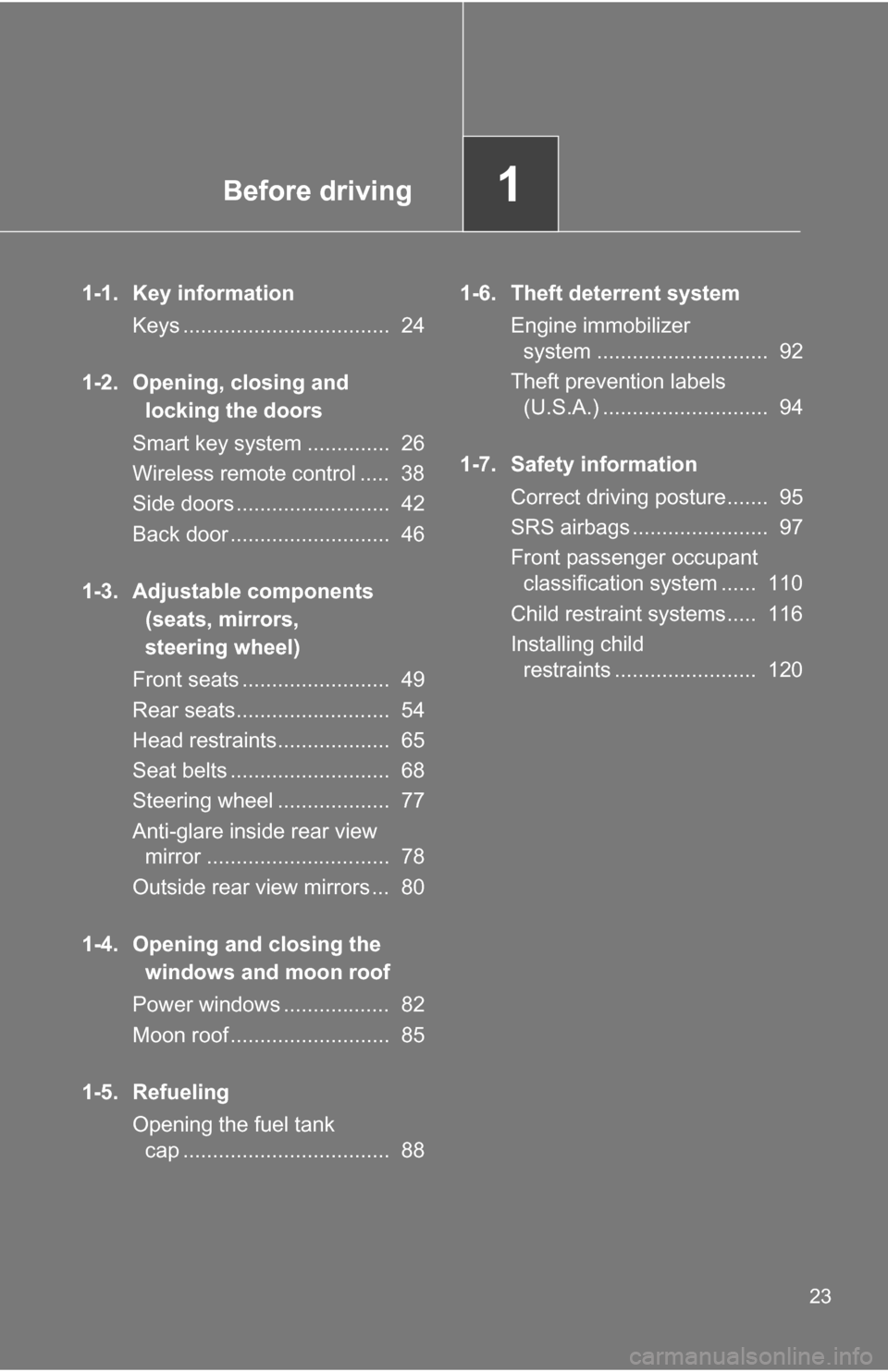
Before driving1
23
1-1. Key informationKeys ................................... 24
1-2. Opening, closing and locking the doors
Smart key system .............. 26
Wireless remote control ..... 38
Side doors .......................... 42
Back door ........................... 46
1-3. Adjustable components (seats, mirrors,
steering wheel)
Front seats ......................... 49
Rear seats.......................... 54
Head restraints................... 65
Seat belts ........................... 68
Steering wheel ................... 77
Anti-glare inside rear view mirror ............................... 78
Outside rear view mirrors ... 80
1-4. Opening and closing the windows and moon roof
Power windows .................. 82
Moon roof ........................... 85
1-5. Refueling Opening the fuel tank cap ................................... 88 1-6. Theft deterrent system
Engine immobilizer system ............................. 92
Theft prevention labels (U.S.A.) ............................ 94
1-7. Safety information Correct driving posture....... 95
SRS airbags ....................... 97
Front passenger occupant classification system ...... 110
Child restraint systems..... 116
Installing child restraints ........................ 120
Page 49 of 516
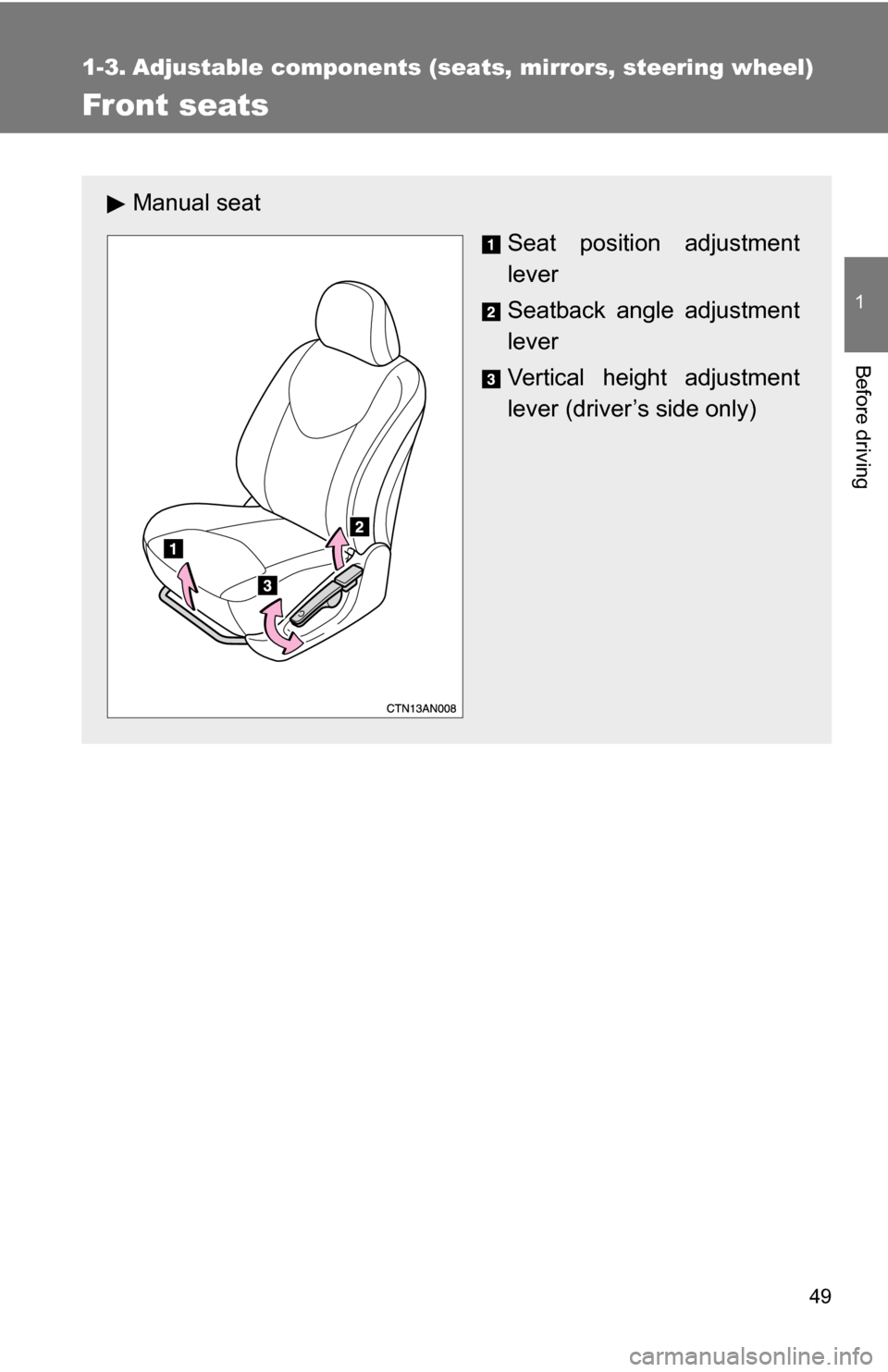
49
1
Before driving
1-3. Adjustable components (seats, mirrors, steering wheel)
Front seats
Manual seat
Seat position adjustment
lever
Seatback angle adjustment
lever
Vertical height adjustment
lever (driver’s side only)
Page 50 of 516
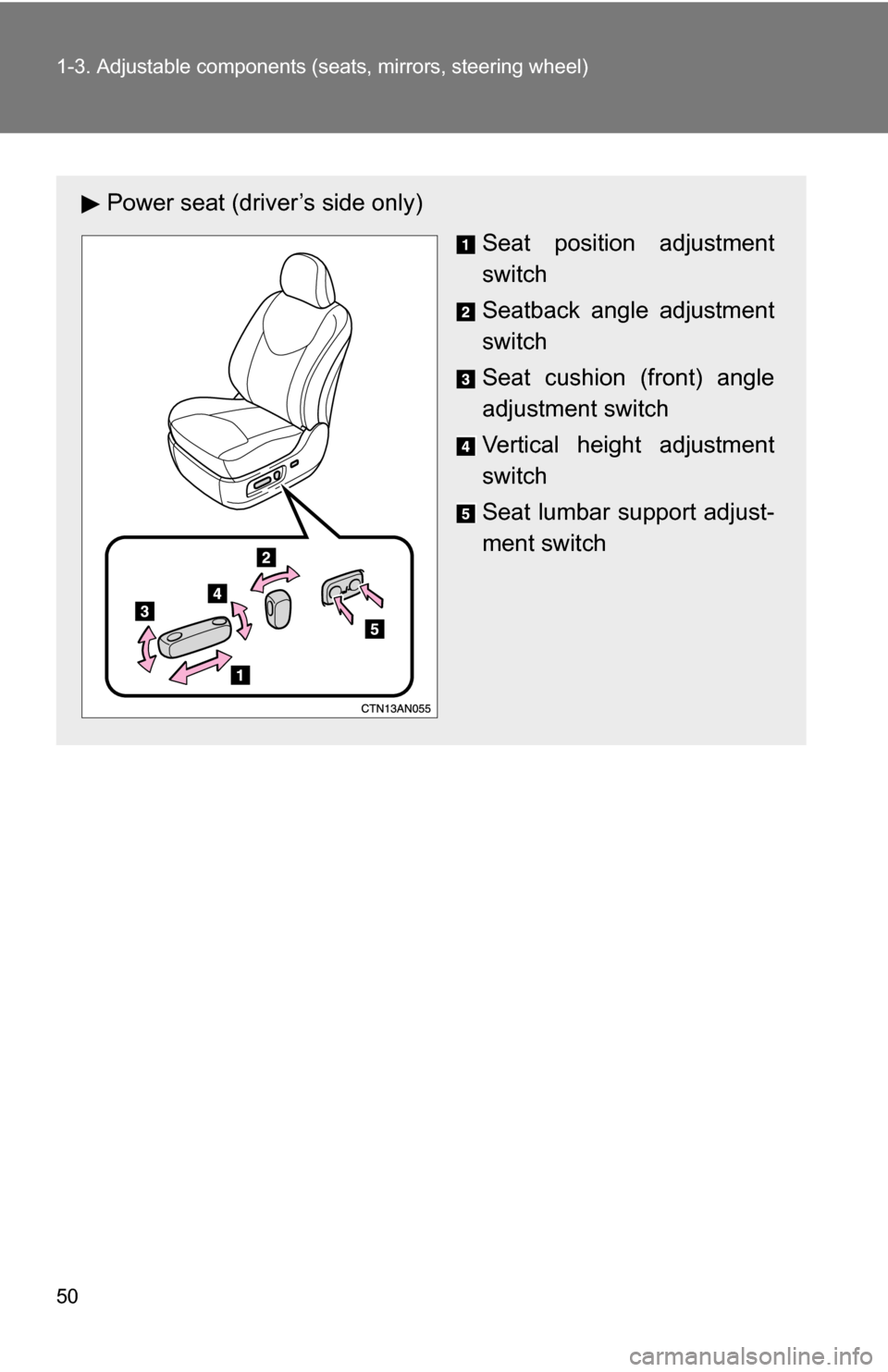
50 1-3. Adjustable components (seats, mirrors, steering wheel)
Power seat (driver’s side only)
Seat position adjustment
switch
Seatback angle adjustment
switch
Seat cushion (front) angle
adjustment switch
Vertical height adjustment
switch
Seat lumbar support adjust-
ment switch
Page 51 of 516
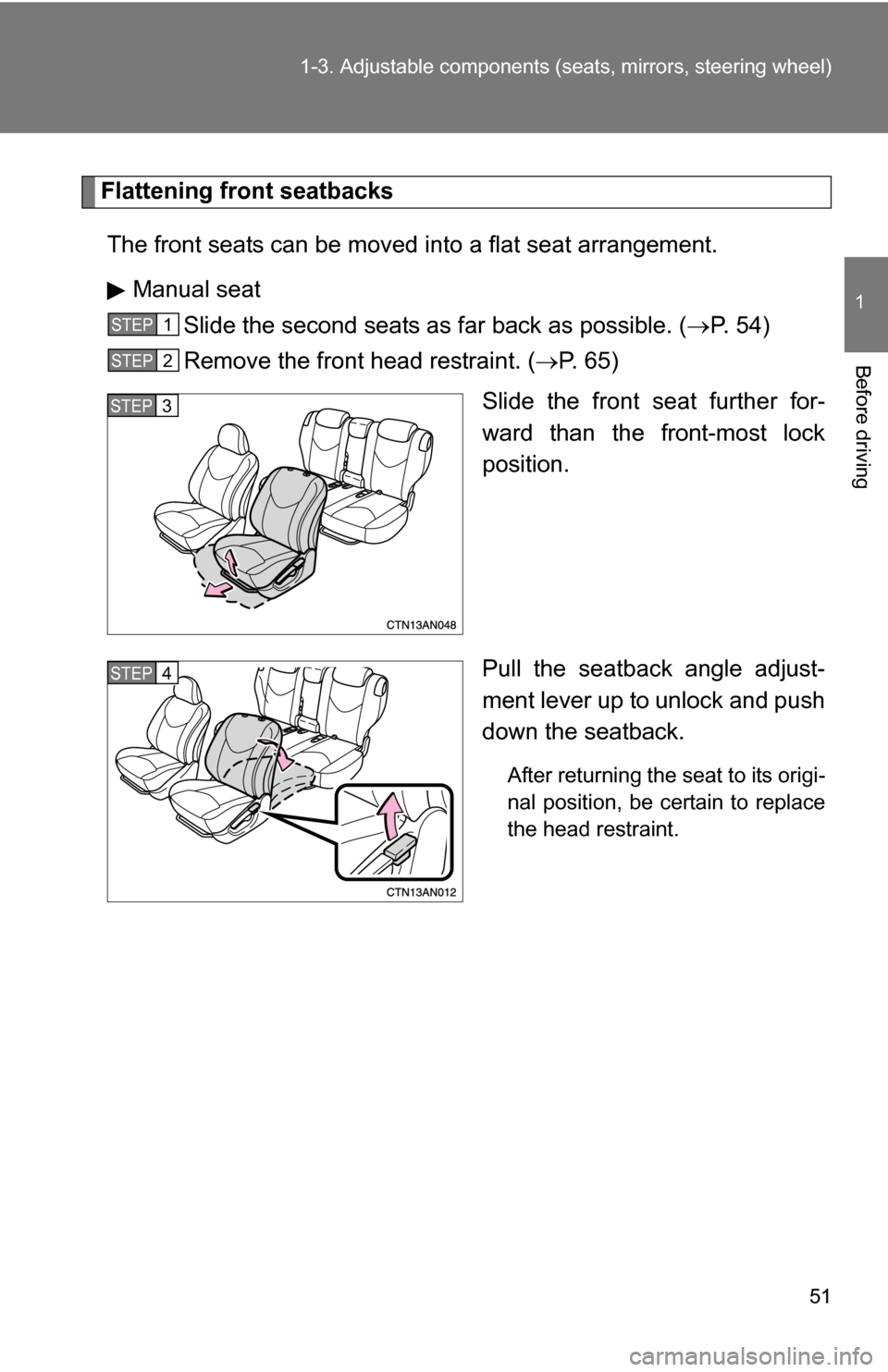
51
1-3. Adjustable components (s
eats, mirrors, steering wheel)
1
Before driving
Flattening front seatbacks
The front seats can be moved into a flat seat arrangement. Manual seat Slide the second seats as far back as possible. ( P. 54)
Remove the front head restraint. ( P. 6 5 )
Slide the front seat further for-
ward than the front-most lock
position.
Pull the seatback angle adjust-
ment lever up to unlock and push
down the seatback.
After returning the seat to its origi-
nal position, be certain to replace
the head restraint.
STEP 1
STEP 2
STEP 3
STEP 4
Page 52 of 516
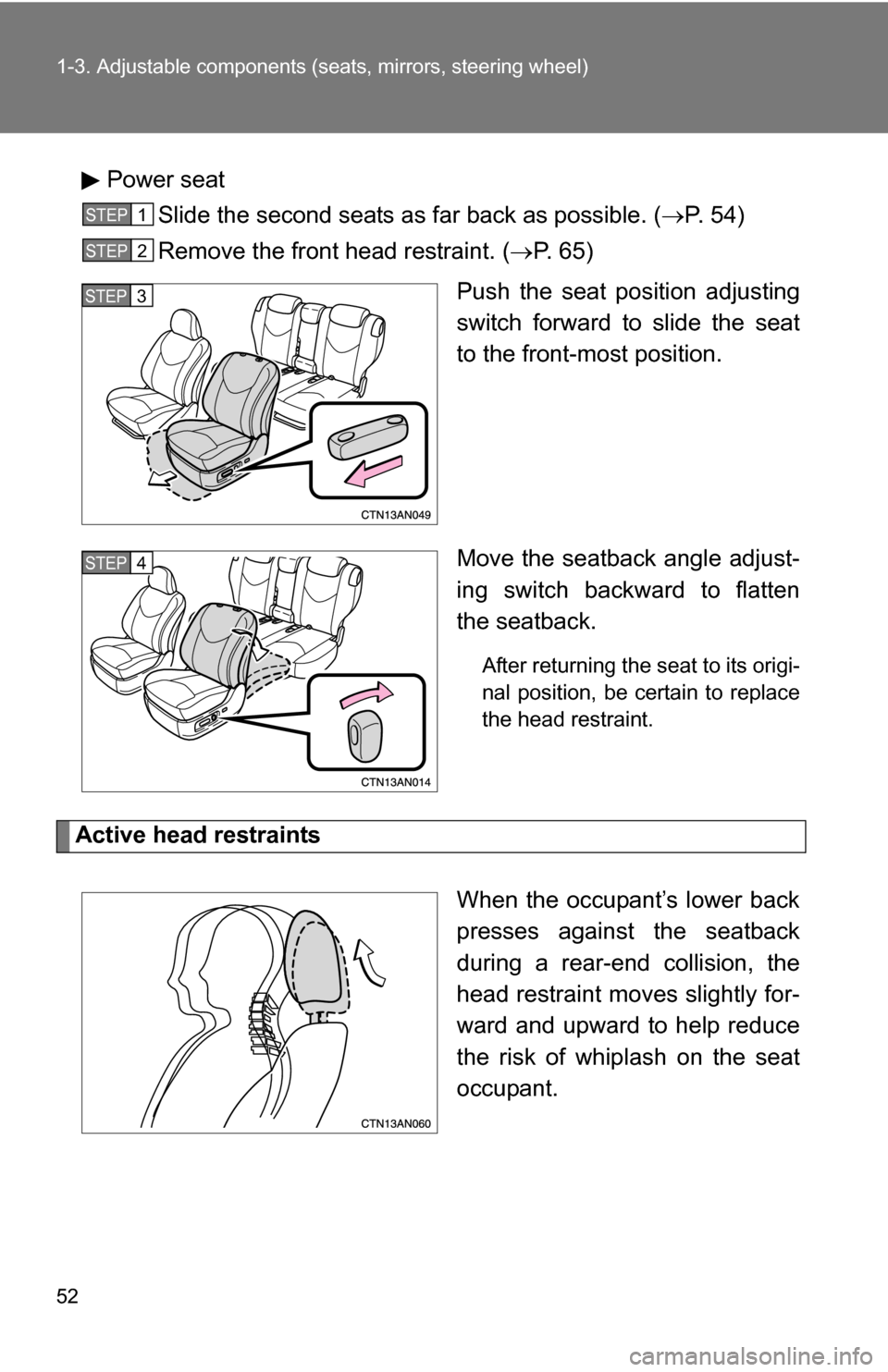
52 1-3. Adjustable components (seats, mirrors, steering wheel)
Power seat
Slide the second seats as far back as possible. ( P. 54)
Remove the front head restraint. ( P. 6 5 )
Push the seat position adjusting
switch forward to slide the seat
to the front-most position.
Move the seatback angle adjust-
ing switch backward to flatten
the seatback.
After returning the seat to its origi-
nal position, be certain to replace
the head restraint.
Active head restraints
When the occupant’s lower back
presses against the seatback
during a rear-end collision, the
head restraint moves slightly for-
ward and upward to help reduce
the risk of whiplash on the seat
occupant.
STEP 1
STEP 2
STEP 3
STEP 4
Page 53 of 516
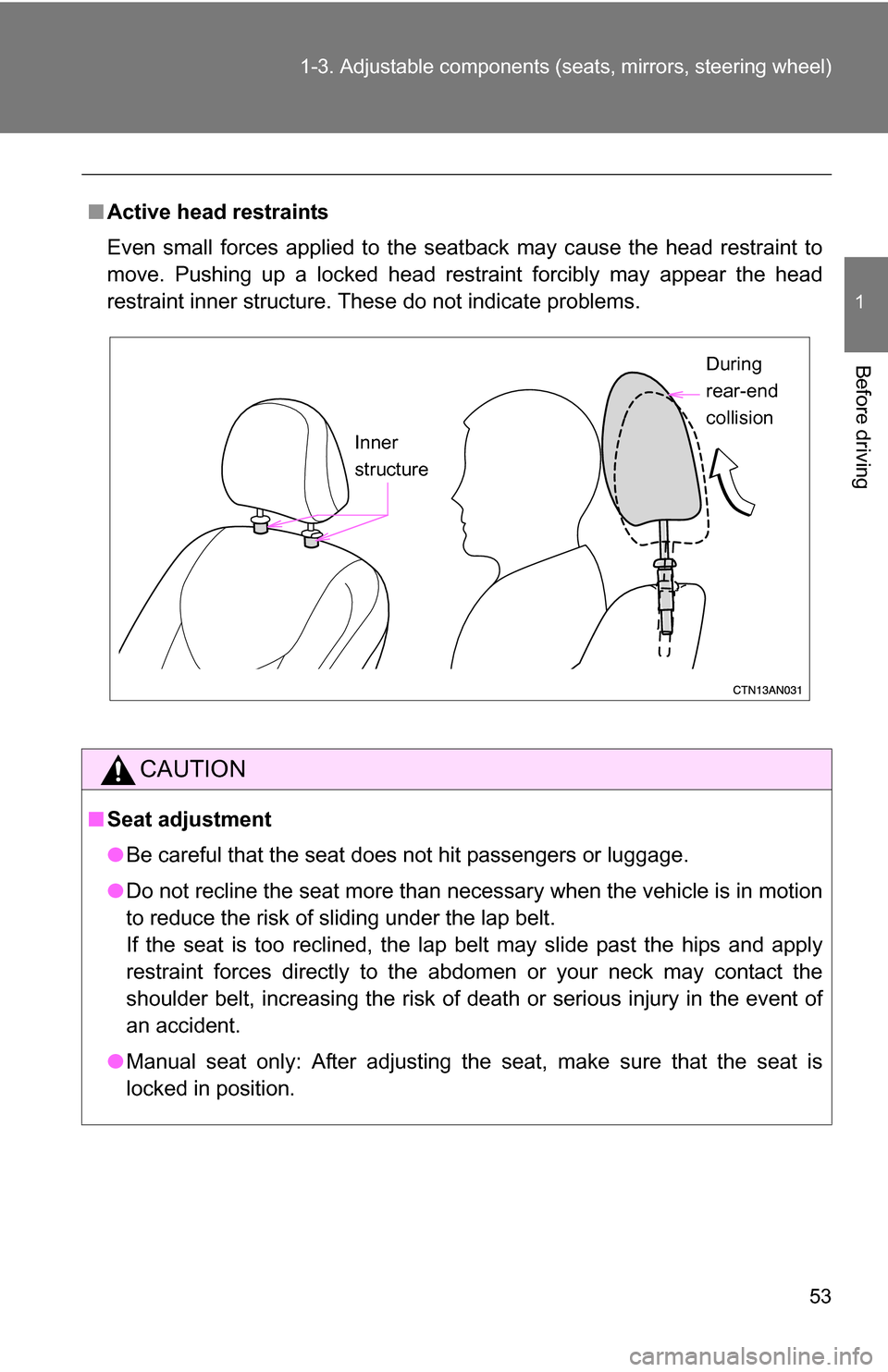
53
1-3. Adjustable components (s
eats, mirrors, steering wheel)
1
Before driving
■Active head restraints
Even small forces applied to the seatback may cause the head restraint to
move. Pushing up a locked head restraint forcibly may appear the head
restraint inner structure. These do not indicate problems.
CAUTION
■Seat adjustment
●Be careful that the seat does not hit passengers or luggage.
● Do not recline the seat more than necessary when the vehicle is in motion
to reduce the risk of sliding under the lap belt.
If the seat is too reclined, the lap belt may slide past the hips and apply
restraint forces directly to the abdomen or your neck may contact the
shoulder belt, increasing the risk of death or serious injury in the event of
an accident.
● Manual seat only: After adjusting the seat, make sure that the seat is
locked in position.
Inner
structure During
rear-end
collision